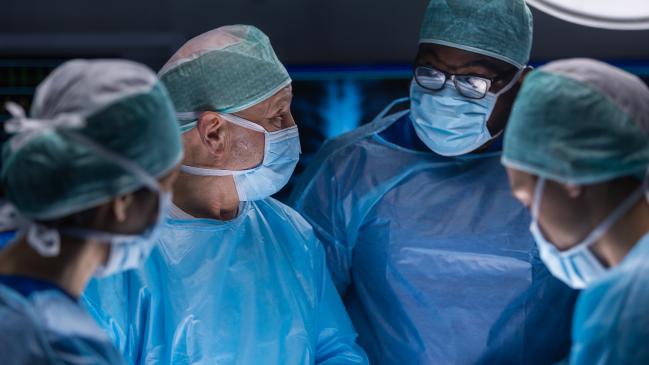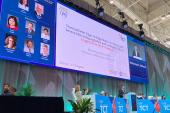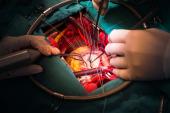Surgeons ‘Implore’ Colleagues to Learn TEER Lest They Become ‘Dinosaurs’
The motive for doing so is unbiased patient care, say those involved, but surgeons’ surgical volumes could also increase.

SAN DIEGO, CA—When it comes to treating mitral valve disease, several leaders of the field at the Society of Thoracic Surgeons (STS) annual meeting urged their peers to take up transcatheter technology, particularly transcatheter edge-to-edge repair (TEER), so as not to potentially be left behind.
While TAVI for aortic stenosis still requires both the sign-off of a surgeon and cardiologist, MitraClip (Abbott Vascular), which is approved for both degenerative and functional mitral regurgitation in the United States, does not.
Presenting data during a session dedicated to controversies in mitral valve surgery, Vinod H. Thourani, MD (Piedmont Heart Institute, Atlanta, GA), showed that despite “phenomenal” mitral valve surgery outcomes over the past decade, surgical volumes have remained stagnant while the number of TEERs with MitraClip has ballooned.
In 2021, 507 US sites were performing MitraClip procedures on more than 13,000 patients, up from just 99 sites and 1,265 patients in 2014. Also, while degenerative MR remains the primary disease etiology for MitraClip, functional MR now makes up about one-third of cases.
And with “zero innovation” happening in the mitral surgery space, Thourani stressed the importance of incorporating transcatheter therapies into practice for surgeons. “I implore you to build your toolbox,” he said, urging them to acquire skills for surgical repair and replacement, minimally invasive procedures, TEER with MitraClip, and transcatheter mitral valve replacement (TMVR). “You have to get involved,” he said.
Patrick Myers, MD (Lausanne University Hospital, Switzerland), secretary general of the European Association for Cardio-Thoracic Surgery (EACTS), who co-chaired a subsequent joint session of EACTS and STS on transcatheter technologies at the meeting, told TCTMD the session was designed to “show the unicorns who are already involved in this space and how other surgeons can get on board and have this real heart team approach toward our patients.”
Patients, he continued, “are already asking for these procedures, and so if we stay in our old ways and don't follow what the patients would like, we'll become the dinosaurs.”
PRIMARY and Surgeon Involvement
Speaking during the session, Joanna Chikwe, MD (Cedars-Sinai Medical Center, Los Angeles, CA), pointed out that there’s never been a non-industry-funded trial comparing percutaneous repair against surgery. That’s set to change with the National Institutes of Health-funded PRIMARY trial, for which she’s serving as principal investigator, comparing TEER versus surgery in patients with primary, degenerative MR.
While some surgeons might be reassured by administrative data showing that the majority of TEER is performed in high-risk patients, that isn’t necessarily the case, Chikwe pointed out.
“Despite the guidelines, at least 25% of patients are actually relatively low risk, with STS PROM scores of 2% or less,” she said. “The justification for clipping them is calling them ‘prohibitive risk,’ because they've got factors such as porcelain aortas or hostile chest. But the vast majority of so-called prohibitive risk patients that get MitraClip for degenerative mitral reparable disease are for frailty, and frailty is highly subjective.”
Surgeons, she added, should be concerned with what a randomized superiority trial of mostly low-risk patients will show. “TEER is a mature technology. Patients want it. Clinicians have got equipoise,” she said. “If we don't have the data within the next few years to inform those conversations, it's going to be game over.”
PRIMARY has been “a challenging trial to enroll, but a year in, we are absolutely on target,” Chikwe reported. “In 3 years, hopefully we’ll give you some really compelling data that will not only inform your practice, [but] will inform [Medicare] coverage determinations, guidelines, and meaningfully shift this conversation in the right direction, whatever we find.”
When asked about the potential for selection bias, Chikwe stressed the importance of choosing patients based on the heart team discussion. “If both partners of the heart team feel the patient can be clipped or repaired satisfactorily, those are the patients who we’re recruiting,” she said, adding that she would like to see surgeons be more involved in MitraClip decision-making “in the same way they are for TAVR, [and] hopefully this trial will provide a platform for that.”
Thourani believes that not only does a conversation need to happen, but also that surgeons should be in the cath lab when the patient undergoes TEER. He suggested at least 1 day a week in the cath lab, acknowledging that while this will reduce their relative value units (RVUs) and require administrative approval, such collaboration is critical to a working relationship. “If we fight, we’re going to lose,” he said. “If we work together, we’re going to make a difference.”
While that might be “the ideal,” Chikwe said, advocating to be more involved is only possible at institutions with “a natural synergy and partnership” between surgery and cardiology. She noted that cardiologists “are essentially the gatekeepers.”
Session co-moderator Michael Halkos, MD (Emory University, Atlanta, GA), noted that “to be really good at mitral valve repair, you have to do a lot of it.” This might pose a hurdle as time is always a limitation, he continued. “Personally, I can't imagine how I can expand to the transcatheter space, and it also doesn't help that unlike TAVR, [surgeons] don't have to be there, technically, for them to do what they do, especially with transseptal. So, it is a big challenge.”
However, Vinay Badhwar, MD (West Virginia University, Morgantown), clarified that surgeons, by the same token, don’t need a cardiologist by their sides to perform a MitraClip procedure either. “The guideline for credentialing for MitraClip is written in a very specific way that it’s not joint, it’s an operator, which can be a cardiologist or a surgeon,” he said.
Informally polling the audience, Chikwe asked: “Who is enthused enough by that to think about training as a MitraClip operator and introducing that concept to their cath lab?” Fewer than 20 hands went up of about approximately 200 attendees.
Transcatheter Content for Surgeons
In the STS/EACTS session, Gorav Ailawadi, MD (University of Michigan, Ann Arbor), posed a similar question to the audience: How many of you have a TEER program at your institution that you’re involved with? While a much larger proportion of attendees raised their hands, one audience member pointed out that he saw no transcatheter technology on display in the exhibit hall at STS.
Interventional cardiologist Pradeep Yadav, MD (Piedmont Heart Institute), also noted there was “very minimal transcatheter content in this meeting. I don't know what message this sends across in our own community.”
Though some surgeons might be interested in transcatheter techniques, changing institutional culture is the bigger challenge, said Neil Moat, MBBS (Abbott Structural Heart, Santa Clara, CA). “Back in the day at EACTS, we ran [transcatheter] courses and the sad thing is we'd run these great all-day courses and then we'd survey 6 months later and say: What happened when you went back to your institution? It was basically, well, nothing happened.”
Highlighting the lack of surgical involvement in TEER, Evelio Rodriguez, MD (Saint Thomas Heart Cardiovascular Surgery, Nashville, TN), presented data showing that surgeons made up just 2% of 3,904 implanting physicians at 524 MitraClip sites in 2022. “This is alarming,” he said. “My call to action is let's learn from a successful TAVR experience. . . . Let's offer our patients a complete mitral valve armamentarium which includes transeptal technologies, and as surgeons, we should be involved. So let's become proficient.”
As to why surgeon involvement is so low, Yadav said: “I don't know if it’s too much RVU pressure, clinical pressure, but ultimately the onus is on the surgeons also to come into the cath lab, take your time out of the OR. And then cardiologists need to realize that if you have a great team, your volume is only going to increase.”
In agreement, Rodriguez said that his institution’s overall surgical volumes have grown with the adoption of MitraClip, as have their participation in clinical trials. “When companies are looking at clinical trial sites, they are looking ideally for places where the surgeons and the cardiologists are involved together, finding these patients and treating them together, so if you want to get the opportunity to do some of these trials, your best chance is having a team where both of you are involved,” he argued.
Ailawadi felt a sense of “déjà vu” from this conversation. “We had this discussion 5 years ago, 7 years ago, and it goes on and on, so what's going to change?” he said. “We've seen some movement with TAVR with our society making the requirements for education, but even in our own center, I don't see our own trainees rushing to come down to do transcatheter cases.”
Ultimately, surgeons need transcatheter skills to be the “most unbiased provider of care,” he stressed.
Thourani said his “open surgical practice has flourished and continues to be bigger than my transcatheter practice because I have transcatheter skills, and the cardiologists have a perspective that because I'm in the cath lab with them, I can do the surgeries, that I have some balance.”
Is Being on the Heart Team Enough?
As to why surgeons have been resistant to learning transcatheter mitral valve skills, audience member Steven Bolling, MD (University of Michigan), attributed it to money. “We can make a lot more money per unit of time in the operating room than we can down in the cath lab,” he said. “In the cath lab, we have to split that RVU with the cardiologist.”
Even so, Rodriguez said he makes more money now than before he started doing MitraClips. “I've got more cases now because I'm part of this,” he said. “So as a surgeon, I really think you’ll be busier.”
Surgeon Gaetano Paone, MD (Emory University), said he doesn’t see the need to perform TEER himself as long as he participates fully in the structural heart program. “It’s more important that the patient get the right procedure and that you’re able to have the conversation amongst the team about [what] procedure should be done than who does it,” he said.
Paone said that while he’s routinely involved in TAVI, BASILICA (laceration of the bioprosthetic leaflet to prevent coronary obstruction), and TMVR cases, interventional cardiologists at his hospital are willing to get him involved if he’s in the cath lab for TEER. “[With] the MitraClips, I could go in there if I really want to and they’ll not hesitate to have me put my hands on the catheter and play with it and try and do it. But I just don’t see the need to waste my time or theirs when I know that the decision to do that procedure was made collectively by our entire team,” said Paone.
Bolling, on the other hand, sees value in being hands-on. “Because I do the MitraClips myself . . . when I get tangled in the subvalvular cords or I'm yanking on the leaflet, I know exactly what I'm yanking on. I know how hard to yank, how much torque it can take, because I’ve been inside that heart and I know what’s going on there,” he said, adding, “That’s why we need to do it because it's better for patients.”
Similarly, Myers, who acknowledged that he doesn’t yet participate in MitraClip procedures, said “it's important to have a great heart team but as somebody who's doing these interventions, I think the more you have in your armamentarium, the more versatile and unbiased in your choice of treatment for patients you'll be. I think it's great to be on the team doing things, but if you really know how to do it, it's a completely different approach to treatment options.”
Yael L. Maxwell is Senior Medical Journalist for TCTMD and Section Editor of TCTMD's Fellows Forum. She served as the inaugural…
Read Full BioSources
Thourani VH. Is it TAVR all over again? Transcatheter treatment of MR. Presented at: STS 2023. January 22, 2023. San Diego, CA.
Chikwe J. PRIMARY trial: why are we doing this? Presented at: STS 2023. January 22, 2023. San Diego, CA.
Rodriguez E. Performing trans-septal mitral valve repair: a must for cardiac surgeons. January 22, 2023. San Diego, CA.
Disclosures
- Rodriguez reports serving on the advisory board for Abbott, Boston Scientific, Cardionet, Edwards Lifesciences, NeoChord, Cardiomech, and Egnite; receiving research support from Abbott, Atricure, Boston Scientific, Edwards Lifesciences, Medtronic, NeoChord, and Cardiomech; and serving as a speaker for Abbott, Atricure, Edwards Lifesciences, and Philips.
- Chikwe reports serving as the principal investigator for PRIMARY and institutional research support and consulting fees from Edwards Lifesciences, Medtronic, and Abbott.
- Ailawadi reports serving on steering committees for trials funded by Abbott, Edwards Lifesciences, and Atricure and serving as a consultant for Medtronic, Abbott, Edwards Lifesciences, Gore, Admedus, Atricure, Johnson & Johnson, Philips, and CryoLife.
- Thourani reports serving on committees for trials funded by Abbott Vascular, Artivion, Boston Scientific, Edwards Lifesciences, and JenaValve; serving as an advisor for Artivion, Boston Scientific, Edwards Lifesciences, and Shockwave; holding equity in Dasi Simulations; and receiving research support from Medtronic.
- Yadav reports serving as a consultant and speaker for Abbott Structural, Boston Scientific, and Edwards Lifesciences.
- Halkos reports serving on the advisory board for Medtronic.
- Myers, Badhwar, and Bolling report no relevant conflicts of interest.





Comments